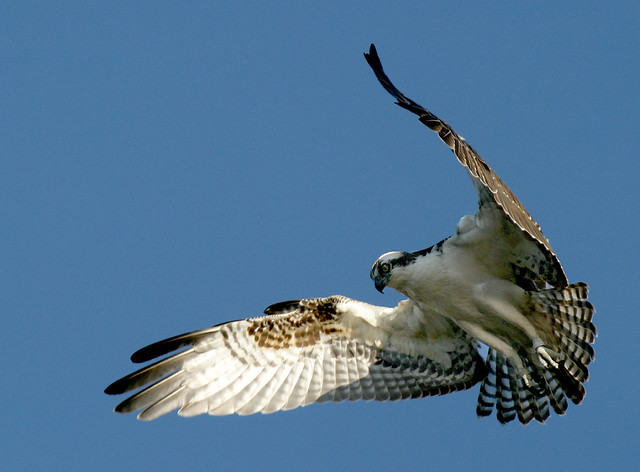Several species of birds inhabiting Scotland have seen their populations decrease in the past decade, including the Northern Lapwing (down 48%) and Eurasian Oystercatcher (-22%). A few birds did see their populations increase, including the Starling (+33%) and Goldcrest (+155%). Read the full story Will these birds vanish from Scotland? in the Scotsman.
Bird Droppings Survive Shuttle Launch
NASA’s rocket scientists have a new appreciation for the out-of-this-world power of bird droppings. The orbiting space shuttle Discovery sported some whitish splotches on its black right wing edge that NASA officials said appeared to be bird droppings. A photo can be found here.
read more | digg story
Osprey Returns To Britain After Migration
“A naturally reared English osprey chick has returned home for the first time in 150 years, boosting hopes of reintroducing the bird across Britain. The two-year-old male, identified as R5, left his nest in Rutland Water, Leics, in September 2004 to migrate to western Africa. He recently returned to his birth place.” Read the full story Hopes for osprey colony raised as bird flies home from Africa.

Osprey Hovering by U. S. Fish and Wildlife Service – Northeast Region, Creative Commons on Flickr
Researchers Find Oldest Known Pigeon Hollandais Bones
A research team from the natural history museum Naturalis in Leiden has discovered bones of the Pigeon Hollandais (Alectroenas nitidissima) on the island of Mauritius. The bones are the oldest ever found of the species.
The bird got the name Pigeon Hollandais from its coloration of white, blue and red, which reminded early observers of the Dutch flag. The species is also known as the Mauritius Blue Pigeon.
The species was heavily hunted in the 17th and 18th centuries. As the habitat of the bird was decimated by deforestation, sightings of the bird were already rare as early as 1730. The bird probably finally became extinct sometime around the 1803’s.
The research team from Naturalis is in Mauritius searching for information on the Dodo Bird. A weblog of their expedition, with some entries in English, can be found here.
Source: Onderzoekers Naturalis vinden botten ‘Hollandse duif’
Long-Haul Migratory Birds ‘Returning Early’
“Birds that migrate long distances have adapted to the world’s changing climate in unexpected ways, a study shows. As the planet warms, and spring arrives earlier in Europe, birds are being forced to change their migration patterns.”
read more | digg story
Indian Farmers Inform On Endangered Birds For Cash
Farmers in Madhya Pradesh who find Lesser Floricans on their lands receive cash incentives for information about the endangered bird and for protecting their nests. Since the pilot program began in 2004, the population of Lesser Floricans has increased from 9 to 26 in the Sailana sanctuary. Read the full story Cash incentive scheme gives endangered bird fresh lease of life in the Indian Express.
Rare Bird Seen After 75 years In Assam, India
The Manipur Bush-Quail, first discovered in the late 1870’s and last seen in the early 1930’s, was thought to be extinct for over 75 years. Two officials from the Manas National Park have spotted what they believe to be a Manipur Bush-Quail in the park. Read the full story Rare bird sighted after 75 years in Asssam in the Deccan Herald.
Wisconsin: Wild Whooping Cranes Hatch Chicks
A pair of wild whooping cranes has hatched two chicks in Wisconsin. They are the first whooping crane chicks to hatch in the wild in this part of the country in over 100 years. The only other wild colony of whooping cranes migrates from Canada to Texas. Go cranes go!
read more | digg story
Norwegian Wind Farm Decimates Local Eagles
Turbines from a wind farm on the Smøla islands off the north-west Norwegian coast have killed at least nine white-tailed eagles in the last ten months. This year, only one chick is expected to fledge from a population that used to produce at least 10 chicks a year. The area is now checked weekly for dead birds as pressure mounts on the Norwegian government to improve proposed wind-farm assessments. Read more in the RSPB story Wind farm strikes at eagle stronghold.
Dogs Kill Protected Birds In Hawaii
Fifteen Laysan Albatrosses, also known as gooney birds, were killed by dogs last week. Although the species is not endangered, only 200 pairs of them nest each year, so the loss of 15 individuals is significant. Because the birds are protected under the Migratory Bird Treaty Act, the dogs’ owners could be fined up to $5,000 and face up to six months in jail. Read more in the Star Bulletin’s story 15 gooney birds killed by dogs at protected site.



